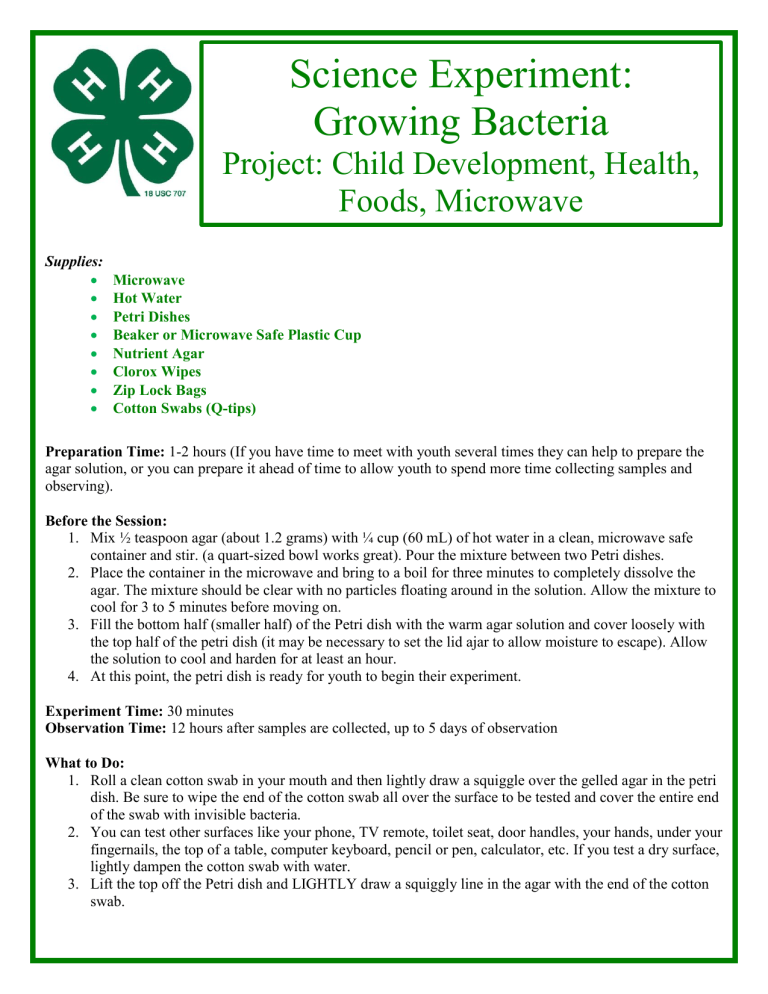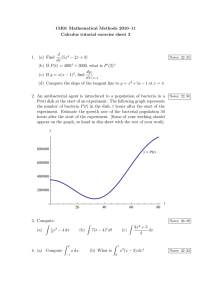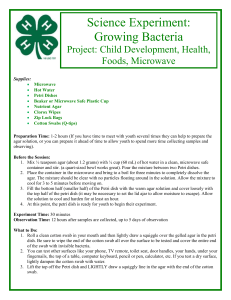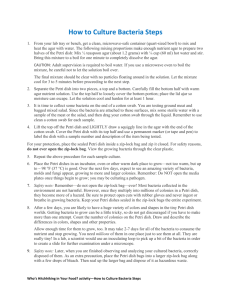
Science Experiment: Growing Bacteria Project: Child Development, Health, Foods, Microwave Supplies: Microwave Hot Water Petri Dishes Beaker or Microwave Safe Plastic Cup Nutrient Agar Clorox Wipes Zip Lock Bags Cotton Swabs (Q-tips) Preparation Time: 1-2 hours (If you have time to meet with youth several times they can help to prepare the agar solution, or you can prepare it ahead of time to allow youth to spend more time collecting samples and observing). Before the Session: 1. Mix ½ teaspoon agar (about 1.2 grams) with ¼ cup (60 mL) of hot water in a clean, microwave safe container and stir. (a quart-sized bowl works great). Pour the mixture between two Petri dishes. 2. Place the container in the microwave and bring to a boil for three minutes to completely dissolve the agar. The mixture should be clear with no particles floating around in the solution. Allow the mixture to cool for 3 to 5 minutes before moving on. 3. Fill the bottom half (smaller half) of the Petri dish with the warm agar solution and cover loosely with the top half of the petri dish (it may be necessary to set the lid ajar to allow moisture to escape). Allow the solution to cool and harden for at least an hour. 4. At this point, the petri dish is ready for youth to begin their experiment. Experiment Time: 30 minutes Observation Time: 12 hours after samples are collected, up to 5 days of observation What to Do: 1. Roll a clean cotton swab in your mouth and then lightly draw a squiggle over the gelled agar in the petri dish. Be sure to wipe the end of the cotton swab all over the surface to be tested and cover the entire end of the swab with invisible bacteria. 2. You can test other surfaces like your phone, TV remote, toilet seat, door handles, your hands, under your fingernails, the top of a table, computer keyboard, pencil or pen, calculator, etc. If you test a dry surface, lightly dampen the cotton swab with water. 3. Lift the top off the Petri dish and LIGHTLY draw a squiggly line in the agar with the end of the cotton swab. 4. Cover the Petri dish with the top half and use a piece of paper or tape to label the dish with the name of the item you tested. Be careful that when you replace the top of the Petri dish, that there is not excessive moisture. You can place the Petri dish upside down if moisture would drop on your sample. 5. After you have complete the sample and labeled the dish, place your Petri dish in a sealed Ziploc bag. 6. Place Petri dishes with samples in a dark and warm place to allow them to grow. You will see growth usually within one day. 7. If you want, track the growth of each sample over several days. You can also clean the surface that you previously tested and try the experiment again. Was the cleaning solution you used successful? How do you know? NOTE: Do NOT open the dishes once things begin to grow. You don’t know exactly what is in the cultures, so just be careful! Reflect: 1. Look at your samples. Do they all look the same? What about smell? Note some of the differences (shape, size, color, smell, amount of bacteria). 2. Are you surprised by the amount of growth in your sample? 3. How do you think the bacteria grew in such a short time? (Bacteria reproduce using binary fission. A bacteria will grow to twice its size and then split into two “daughter” bacteria with the same genetic code. Some bacteria can reproduce once every 20 minutes.) 4. What would adding hand sanitizer to your sample do? Make a hypothesis and try it out. You can add hand sanitizer drops during the initial collection or after bacteria have started growing. Apply: Bacteria may seem gross and like something that we don’t want around very much. However, there are several helpful types of bacteria that are helpful in our lives and some we simply can’t live without. Can you think of ways that bacterial are helpful? Good bacteria comes in many different types. Bacteria helps you digest your food (probiotics) and is used to make some dairy products and some types of medicines. Bacteria are also some of the best decomposers meaning that they break down dead and decaying organic matter from leaves to insects. What other things could bacteria be used for? Bacteria are now being used for environmental cleanup, especially for oil spills.




